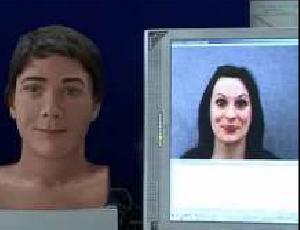Jules, the first human robot that is able to imitate facial expressions and grimaces in real time, and is able to recognize and copy ten emotions, including happiness, sadness and worry - was developed by researchers in England
Nechama Almog, ThePeople system, DailyMaily

A robot called Jules, located in the Robotics Laboratory at the University of Bristol, recognizes and copies ten emotions, including happiness, sadness and worry. The technological breakthrough was developed over three and a half years by a team from the University of Bristol's Robotics Laboratory in collaboration with the University of the West of England, and the head was created by David Hanson, a famous American researcher and robot designer. The technology will help produce a new generation of humanoid robots, Able to communicate with people in a convincing and reliable way and serve as companions for older people, assist astronauts in space or perform many other tasks.
Jules' camera "eyes" scan the face and recognize movements and expressions, which are immediately translated into digital instructions, which are copied and executed by the 34 internal motors implanted in Jules' head. The "skin" of the robot's head is made of a flexible material, called flavor (a semi-flexible and semi-solid material with viscous properties), and allows it to smile, contort its face and even move its eyebrows. Jules is able to carry out the digital instructions at a speed of 25 frames per second, so he can mirror even the subtlest movements of his companion almost instantly.
Studies in the world predict that in the future, Robotic companions They will perform tasks and help people in various fields, such as education, care, industry, service and more. A famous theory called "Uncanny Valley" (loosely translated as "the unnatural pit"), published in the early seventies, talks about repulsion and nausea reactions of people from non-human robots, which can sabotage efforts to achieve credibility, trustworthiness and emotional intelligence. All these are the basic assumptions, which are prerequisites to develop robots that will be used as companions or as service providers.
Peter Jackel, the researcher at the head of the project, who specializes in artificial emotions and humanoids, says that "the human appearance of robots is a decisive feature in human-robot interaction, and the appearance and behavior of robots must accurately correspond to human reactions, in order to meet expectations that we, as people, know from our social experience. Violation of these expectations, even due to subtle deficiencies or due to an imbalance between external appearance and behavior, causes discomfort and rejection in people who look at the robot."
Jackel adds that the research he is leading tries to promote dynamic and realistic facial expressions in humanoid robots and focuses on very subtle facial expressions, compared to other studies in this field, which focus on exaggerated, frozen and non-dynamic facial movements. "We researched different ways to capture human facial expressions using video for the purpose of animating robotic faces," he says. Robot heads that mimic human expressions have been developed before, but never ones with such realistic faces.
Despite the enthusiasm that this research has aroused in many media, there are researchers who claim that people may actually feel embarrassed and react negatively when faced with robots that have many human characteristics, which seem "Too human".
Apparently the period described in the book "I am a robot"Getting closer and closer". It is interesting, by the way, how this system will be integrated inA robot capable of sensing touch.

6 תגובות
Like the bank manager smiling at you
"Despite the enthusiasm generated by this research in many media, some researchers claim that people may actually feel embarrassed and react negatively in front of robots that have many human qualities, that seem "too human".
Apparently the period described in the book "I am a robot" is getting closer. It is interesting, by the way, how this system will be integrated into a robot capable of sensing touch."
More reminiscent of the robot R. Daniel Olivao from the book "Caves of Steel" and the rest of Asimov's robot series and in these books (mainly "Caves of Steel" and "Robots of Dawn") it is really about the relationship between humanoid robots and humans
And the article by Bill Gates who bothers and publishes in Scientific American an entire article about robots as a future forecast is in general a very interesting topic and worthy of thought - why is he putting the spotlight on it?
This new one is much more interesting on a practical level:
By 2025, robots will replace people in jobs that do not involve skill and education
A report, prepared by the American National Intelligence Council, predicts that robots will be used by us in industry, on the battlefield, in the service of people - and will revolutionize the labor markets and immigration patterns in the world ● Are the prophecies of Isaac Asimov coming true?
https://www.hayadan.org.il/robot-will-replace-people-0412082/
I wonder what the practical use of this will be?
Just to make the people served by the robot more comfortable? Doesn't sound like a good enough goal to me
Here is the "design news" in a huge sales coaching project